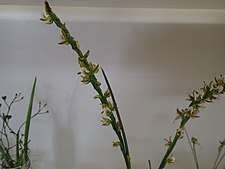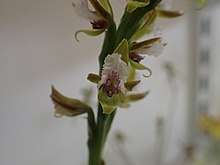Prasophyllum fimbria
Prasophyllum fimbria, commonly known as the fringed leek orchid, is a species of orchid endemic to the south-west of Western Australia. It is a tall orchid with a single smooth, tube-shaped leaf and up to seventy greenish-brown flowers with a white and pink labellum.

| Fringed leek orchid | |
|---|---|
 | |
| Prasophyllum fimbria at the Ravensthorpe Wildflower Show | |
| Scientific classification | |
| Kingdom: | Plantae |
| Clade: | Tracheophytes |
| Clade: | Angiosperms |
| Clade: | Monocots |
| Order: | Asparagales |
| Family: | Orchidaceae |
| Subfamily: | Orchidoideae |
| Tribe: | Diurideae |
| Subtribe: | Prasophyllinae |
| Genus: | Prasophyllum |
| Species: | P. fimbria |
| Binomial name | |
| Prasophyllum fimbria | |
Description
Prasophyllum fimbria is a terrestrial, perennial, deciduous, herb with an underground tuber and a single smooth, tube-shaped leaf 200–800 mm (8–30 in) long and 5–10 mm (0.2–0.4 in) in diameter near the base. Seventy or more flowers are arranged on a flowering spike 60–200 mm (2–8 in) high which varies in colour from green to almost black. The flowers are greenish-brown, about 18 mm (0.7 in) long and 9–10 mm (0.35–0.39 in) wide. As with others in the genus, the flowers are inverted so that the labellum is above the column rather than below it and the dorsal sepal is the lowest part of the flower. The petals face forwards and the lateral sepals are erect and joined at their sides. The labellum is white and curves upwards with a frilly edge. In the centre of the labellum is a frilly, pinkish callus. Flowering occurs from June to September and is more prolific after fire the previous summer.[1][2][3]
Taxonomy and naming
Prasophyllum fimbria was first formally described in 1871 by Heinrich Reichenbach and the description was published in Beitrage zur Systematischen Pflanzenkunde.[4][5] The specific epithet (fimbria) is a Latin word meaning "fringe"[6] referring to the frilly edges of the labellum.[2]
Distribution and habitat
The fringed leek orchid grows in a range of habitats from swamps to heath and woodland. It occurs from Kalbarri in the north to Esperance in the east.[2][1][7]
Conservation
This orchid is classified by the Western Australian Government Department of Parks and Wildlife as "not threatened" .[7]
References
- Hoffman, Noel; Brown, Andrew (2011). Orchids of South-West Australia (3rd ed.). Gooseberry Hill: Noel Hoffman. p. 371. ISBN 9780646562322.
- Brown, Andrew; Dundas, Pat; Dixon, Kingsley; Hopper, Stephen (2008). Orchids of Western Australia. Crawley, Western Australia: University of Western Australia Press. p. 333. ISBN 9780980296457.
- Archer, Wiilliam. "Prasophyllum fimbria". Esperance Wildflowers. Retrieved 15 October 2017.
- "Prasophyllum fimbria". APNI. Retrieved 15 October 2017.
- Reichenbach, Heinrich G. (1871). Beitrage zur Systematischen Pflanzenkunde. Hamburg. p. 60. Retrieved 15 October 2017.
- Brown, Roland Wilbur (1956). The Composition of Scientific Words. Washington, D.C.: Smithsonian Institution Press. p. 157.
- "Prasophyllum fimbria". FloraBase. Western Australian Government Department of Parks and Wildlife.
External links

